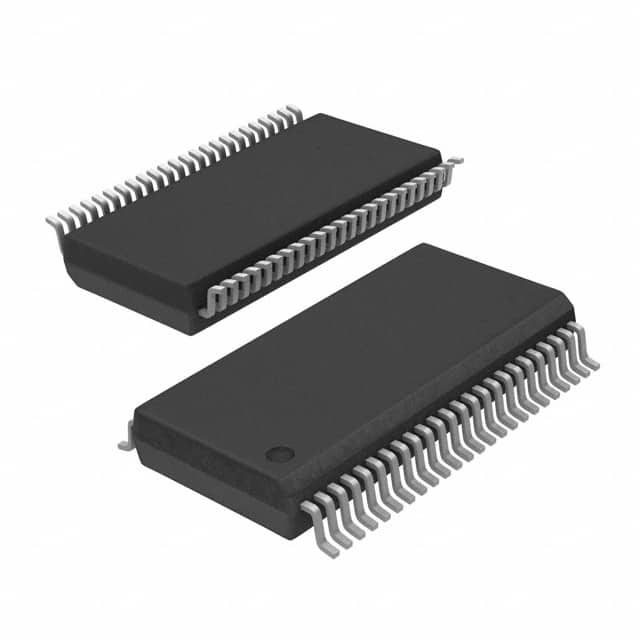Viz Specifikace pro podrobnosti o produktu.

Encyclopedia Entry: 74ALVC16245PAG
Product Overview
- Category: Integrated Circuit (IC)
- Use: Signal Buffer/Transceiver
- Characteristics: High-speed, low-power, bidirectional voltage level translation
- Package: TSSOP (Thin Shrink Small Outline Package)
- Essence: The 74ALVC16245PAG is a 16-bit bus transceiver with 3-state outputs, designed for voltage level translation between different logic families.
- Packaging/Quantity: Available in reels of 2500 units.
Specifications
- Supply Voltage Range: 1.2V to 3.6V
- Input Voltage Range (High Level): 2.0V to VCC + 0.5V
- Input Voltage Range (Low Level): -0.5V to 0.8V
- Output Voltage Range (High Level): 2.4V (min) at IOH = -24mA
- Output Voltage Range (Low Level): 0.4V (max) at IOL = 24mA
- Propagation Delay: 2.7ns (typical)
- Operating Temperature Range: -40°C to +85°C
Detailed Pin Configuration
The 74ALVC16245PAG has a total of 48 pins, divided into two groups: - Group A (pins 1-24): Inputs/Outputs for Port A - Group B (pins 25-48): Inputs/Outputs for Port B
For detailed pin configuration and functions, refer to the datasheet or manufacturer's documentation.
Functional Features
- Bidirectional data flow: Allows data transmission in both directions.
- 3-state outputs: Enables multiple devices to share a common bus without interference.
- High-speed operation: Suitable for applications requiring fast data transfer.
- Low-power consumption: Helps reduce overall power consumption in electronic systems.
Advantages and Disadvantages
Advantages: - Wide supply voltage range allows compatibility with various logic families. - 3-state outputs facilitate bus sharing and reduce conflicts. - High-speed operation enables efficient data transfer.
Disadvantages: - Limited output voltage range may not be suitable for all applications. - Propagation delay may affect timing-sensitive systems.
Working Principles
The 74ALVC16245PAG operates as a bidirectional buffer/transceiver, translating voltage levels between two logic families. It uses a combination of input/output buffers and control circuitry to enable bidirectional data flow. The 3-state outputs allow multiple devices to share a common bus without interference.
Detailed Application Field Plans
The 74ALVC16245PAG is commonly used in various applications, including: 1. Microprocessor/Controller Interfacing: Enables communication between different logic families in embedded systems. 2. Data Communication Systems: Facilitates voltage level translation in serial and parallel communication interfaces. 3. Memory Modules: Allows data transfer between memory modules operating at different voltage levels. 4. Industrial Automation: Used in control systems to interface between different logic families.
Detailed Alternative Models
- SN74LVC16245A: Similar 16-bit bus transceiver with 3-state outputs, offered by Texas Instruments.
- MC74LVX245: Another 16-bit bidirectional transceiver, available from ON Semiconductor.
- CD74HCT245: Octal bus transceiver with 3-state outputs, manufactured by Texas Instruments.
These alternative models offer similar functionality and can be considered based on specific requirements and availability.
Word count: 408 words
Seznam 10 běžných otázek a odpovědí souvisejících s aplikací 74ALVC16245PAG v technických řešeních
Sure! Here are 10 common questions and answers related to the application of 74ALVC16245PAG in technical solutions:
Q: What is the 74ALVC16245PAG? A: The 74ALVC16245PAG is a 16-bit transceiver with 3-state outputs, designed for low-voltage applications.
Q: What is the voltage range supported by the 74ALVC16245PAG? A: The 74ALVC16245PAG supports a voltage range of 1.2V to 3.6V.
Q: Can the 74ALVC16245PAG be used for bidirectional data transfer? A: Yes, the 74ALVC16245PAG can be used for bidirectional data transfer between two buses.
Q: How many channels does the 74ALVC16245PAG have? A: The 74ALVC16245PAG has 16 channels, allowing it to handle 16 bits of data simultaneously.
Q: What is the maximum data rate supported by the 74ALVC16245PAG? A: The 74ALVC16245PAG can support data rates up to 400 Mbps.
Q: Can the 74ALVC16245PAG be used in mixed-voltage systems? A: Yes, the 74ALVC16245PAG is compatible with mixed-voltage systems, making it suitable for interfacing between different voltage domains.
Q: Does the 74ALVC16245PAG have built-in ESD protection? A: Yes, the 74ALVC16245PAG has built-in ESD protection, providing robustness against electrostatic discharge events.
Q: What is the power supply voltage required for the 74ALVC16245PAG? A: The 74ALVC16245PAG requires a power supply voltage of 1.2V to 3.6V.
Q: Can the 74ALVC16245PAG be used in high-speed applications? A: Yes, the 74ALVC16245PAG is designed for high-speed operation and can be used in applications that require fast data transfer.
Q: Are there any special considerations for PCB layout when using the 74ALVC16245PAG? A: Yes, it is recommended to follow the manufacturer's guidelines for PCB layout, including proper decoupling and signal integrity practices, to ensure optimal performance of the 74ALVC16245PAG.

